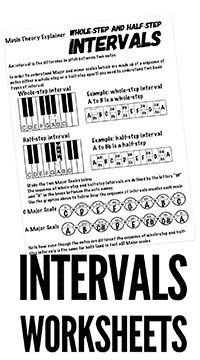What Is Diatonic Harmony?
Diatonic harmony (the basis of much of the music that we hear, play and write today) can be defined as being a system by which all of the chords used in a song or composition are constructed by using the notes of a single major scale
Even though the root notes of the chords produced differ from key to key the chord qualities (Major, minor or diminished) remain constant
The Rules Of Diatonic Harmony
The chord based on the first note of any Major Scale will always be a Major chord
The chords built on the second and third degrees of the scale will always be minor
Chords with root notes on the fourth and fifth degrees of the scale will always be major
The chord built on the sixth degree of the scale will always be minor whilst the triad built from the seventh degree of the scale will always be a diminished chord

Above you can see (along with the diatonic puzzle on the right of the image) two worksheets that do not feature in the twelve learning packs but which form part of the main download
On the left there is one of a series of music theory resources aimed at students who play guitar
and the handout in the middle is a "quick reference" guide for all students regardless of which instrument they operate onDownload a free Diatonic Harmony Worksheet

How to teach Diatonic Harmony
Diatonic Harmony provides a framework by which music students can develop an understanding of all of the chords to be found in any particular key.
An understanding of the diatonic system will allow students to examine a chord sequence and to decide which scale it is based upon as well as to give them the knowledge to compose musically "correct" chord sequences of their own.
A feature of the printable music worksheets available from our site is that they aim to encourage the development of a "joined up" understanding of the diatonic system. The materials contain a series of "diatonic puzzles" (click the image above to download a free printable music worksheet) that contain all of the chords from a particular key (in the case of the free sheet the key is D)
Stdents are invited to firstly identify the chords on the worksheet and then to name the key that all of the triads belong to.
It is likely (and desirable) that as they progress through the sheets they will begin to develop an ability to identify the key before they have named all of the chords on the sheet by using an increasing understanding of the system and the chords within it.
An example of this understanding might be that they come to realise (rather than just be able to recite) that chord no VII is always a diminished chord (in the case of the sample sheet C# diminished) and that the tonic (name) chord of the key is a major chord a semitone above the root of chord no VII (a D chord?)
Another example would be that two major triads a tone apart might be identified (G and A on the free worksheet)?
Armed with this information students would be able to deduce the key containing all of the chords on the sheet by correctly identifying the lower of these major triads (G) as chord IV (the subdominant) and the higher one (an A chord) as Chord no V ( the dominant chord)
As there is only one Major key (in this case D) which features these two chords then identification of the parent key could become fairly simple by addressing the following questions
Which scale has a fourth note of G (the root note of a G major triad)?
Material relating to the diatonic system forms part of our package that music teachers can now download featuring 400 professionally prepared printable music worksheets that can be printed over and over again and all for less than the price of a single paper based textbook!
These resources are put together to make life easier for classroom music teachers and instrumental instructors . They have been devised so that a single music educator might work with all ability levels within a single session or work back to basic principles with an individual student.

Music Theory Learning Pack 10
Diatonic Harmony: 1
The last three of the twelve basic music theory packs deal with the subject of how chords work within keys
The first of these packs features a document explaining the principles of diatonic harmony (the series of Major and minor chords that can be constructed from the notes of any "parent" Major Scale) alongside two worksheets looking at the chords that can be found within particular keys. The three packs feature worksheets that each contain chords made up (only) of the notes that can be found within a single Major scale. Students are required to identify the chords and then having done that they have the task of identifying the Major key to which all of the chords belong

Music Theory Learning Pack 11
Diatonic harmony: 2
The "explainer" again along with three more worksheets. "Diatonic Puzzles" that invite learners to identify first a series of chords and then the keys to which the chords belong

Music Theory Learning Pack 12
Diatonic Harmony: 3
A final pack that (again) has the "explainer" alongside four more diatonic puzzles which require students to identify (first) a series of chords and (then) the key to which the chords belong

There Are Another 350 + PDFs In The Download
The Basic Music Theory Course is a very important part of the download but it is only a small part of the story!
There are loads of resources that do use notation as well as a bunch of guitar themed handouts and worksheets
Material covering Blues and Pentatonic scales, 7th chords and inversions We also provide material relating to popular song form
A simple to use"Must have Toolkit" for the modern music educator for less than the price of a single textbook
$18.00
DOWNLOAD 400+ Printable Music Worksheets Now
A lifetime of "Year-on-Year" re-usable resources for only $18.00
How to access with a simple "one click" download
Buy your music worksheets in complete safety via any major credit card (through paypal) or directly through your paypal account if you have one. If you choose to use a credit card, rest assured that we never see your credit card details as paypal do all of that for us.
When Paypal receive your payment you will be immediately invited to click a
"RETURN TO MERCHANT"button.
You will be taken to a page from where you can download the printable music worksheets that you have paid for NOW!
In the (rare) event that something should go wrong with the order/download process just email me at robh@teachwombat.com
I will check the order and send you the links that will get you to your stuff.
Cheers! Rob!

















